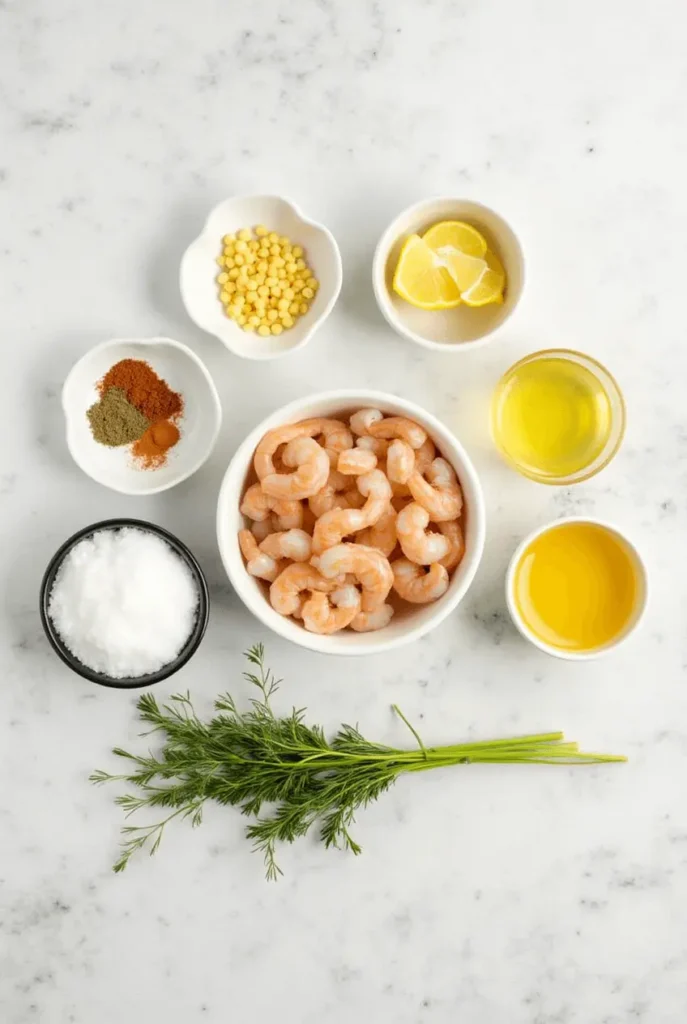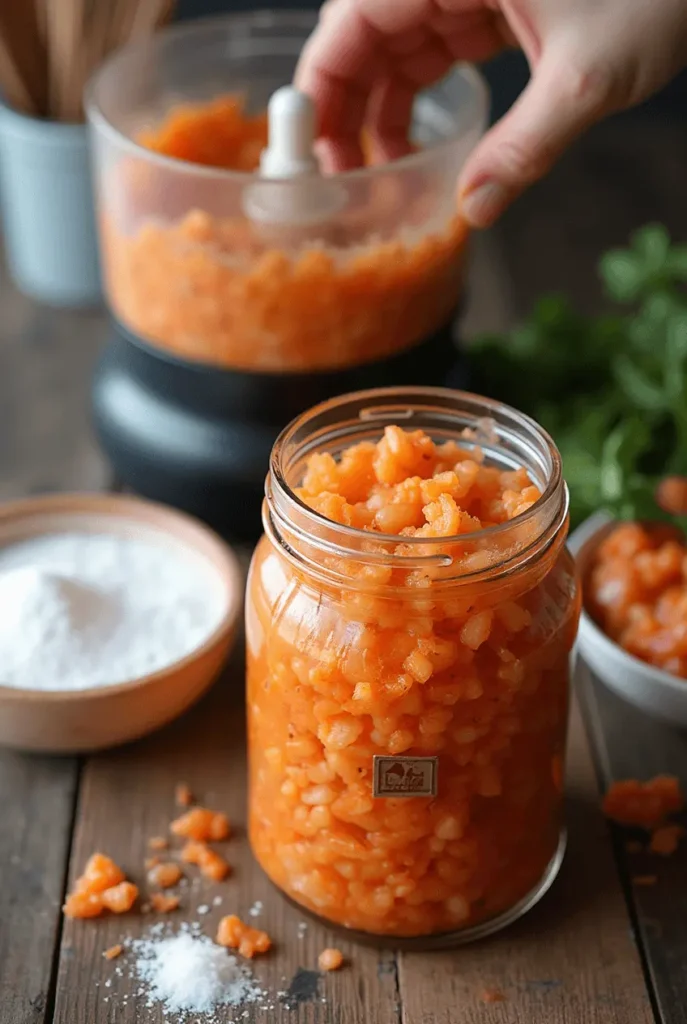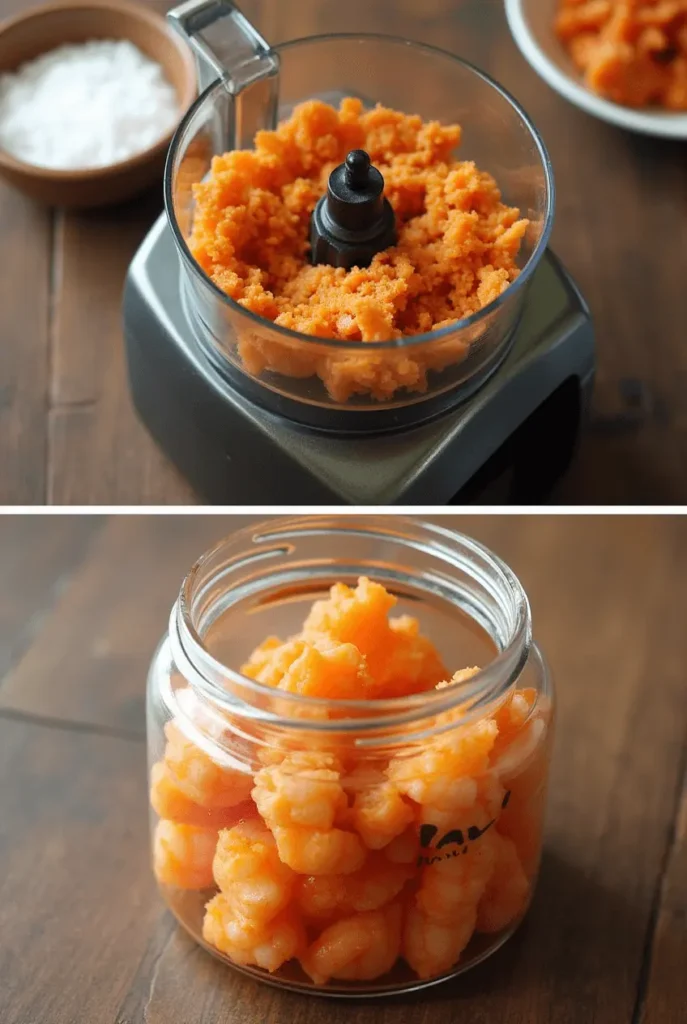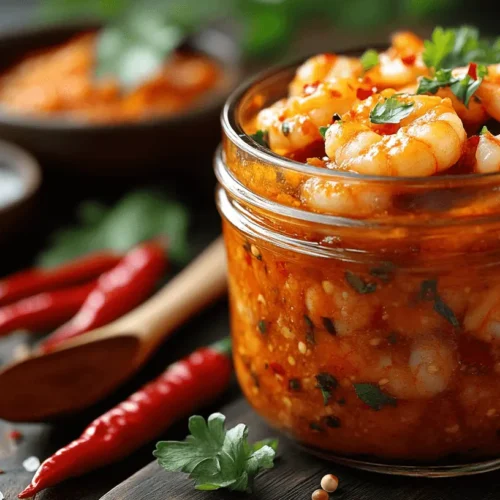There’s something magical about shrimp paste—a humble ingredient that packs a punch of umami flavor and transforms ordinary dishes into extraordinary culinary experiences. If you’ve ever wondered how to recreate that rich, savory depth at home, you’re in for a treat. This irresistible shrimp paste recipe is not only easy to make but also allows you to customize the flavor to suit your taste buds. Whether you’re a seasoned cook or a curious beginner, this recipe will become a staple in your kitchen.
Growing up, my grandmother always had a jar of homemade shrimp paste tucked away in her pantry. She’d add a spoonful to her soups, stir-fries, and even dipping sauces, and the result was always unforgettable. Her secret? Fresh ingredients and a little patience. Inspired by her tradition, I’ve crafted this recipe to bring that same authentic, bold flavor to your table.
What makes this shrimp paste truly special is its versatility. It’s gluten-free, dairy-free, and free from preservatives, making it a healthier alternative to store-bought versions. Plus, the process of making it is surprisingly simple—just a few steps and some time for fermentation, and you’ll have a condiment that elevates everything from noodles to grilled meats.
So, if you’re ready to dive into the world of homemade flavors, grab your apron and let’s get started. This shrimp paste recipe is more than just a condiment—it’s a journey into the heart of bold, authentic cooking. Trust me, once you try it, you’ll wonder how you ever lived without it.
Key Benefits: Why You’ll Love This Shrimp Paste Recipe
Making your own shrimp paste at home isn’t just a culinary project—it’s a game-changer for your kitchen. Here’s why this recipe is worth your time and effort:
1. Unbeatable Flavor
Homemade shrimp paste delivers a depth of umami that store-bought versions simply can’t match. By controlling the ingredients and fermentation process, you can create a paste that’s rich, savory, and perfectly balanced to your taste. Whether you’re adding it to stir-fries, soups, or dipping sauces, the flavor will shine through in every bite.
2. Healthier and Cleaner Ingredients
When you make shrimp paste at home, you know exactly what goes into it. No preservatives, no additives—just fresh shrimp, salt, and optional flavor enhancers like garlic or chili peppers. This makes it a healthier choice for you and your family, especially if you’re mindful of processed foods.
3. Customizable to Your Preferences
What makes this recipe truly special is how adaptable it is. Crave a spicier kick? Toss in extra chili peppers. Prefer a milder taste? Adjust the salt or shorten the fermentation time. You have full control, allowing you to craft a condiment that perfectly matches your preferences.
4. Versatility in the Kitchen
Shrimp paste is a secret weapon for adding depth to a wide range of dishes. Use it as a base for curries, a marinade for grilled meats, or a flavor booster for fried rice. Its versatility makes it a must-have in any kitchen, and once you start using it, you’ll find endless ways to incorporate it into your cooking.
5. A Fun Culinary Adventure
Making shrimp paste is more than just cooking—it’s an exploration of tradition and flavor. The fermentation process is fascinating, and the result is a condiment that connects you to global culinary practices. There’s also an unmatched sense of pride that comes from crafting something entirely from scratch.
6. Cost-Effective and Sustainable
Buying shrimp paste can add up over time, especially if you cook with it frequently. Making it at home is not only cost-effective but also reduces packaging waste, making it a more sustainable choice.
Pro Tips for Success
- Use Fresh Shrimp: The quality of your shrimp directly impacts the final flavor. Opt for fresh, high-quality shrimp for the best results.
- Patience is Key: Fermentation takes time, but it’s worth the wait. Let the flavors develop fully for a richer taste.
- Experiment with Flavors: Don’t be afraid to tweak the recipe. Add garlic, chili, or even a touch of sugar to create your signature blend.
Ingredients: What You’ll Need for Homemade Shrimp Paste

Creating your own shrimp paste requires just a handful of simple, high-quality ingredients. Here’s everything you’ll need to get started:
Main Ingredients
- Fresh Shrimp (500g): The star of the show! Opt for small, fresh shrimp with shells on, as they add depth to the flavor. If fresh shrimp aren’t available, frozen shrimp (thawed) work too.
- Salt (50g): Salt is essential for both flavor and preservation. Use fine sea salt or kosher salt for even distribution.
Optional Flavor Enhancers
- Garlic (3-4 cloves, minced): Adds a subtle aromatic kick.
- Chili Peppers (2-3, finely chopped): For a spicy version, use fresh red chilies or chili flakes.
- Sugar (1 tsp): Balances the saltiness and enhances the umami flavor.
Equipment
- Food Processor or Mortar and Pestle: For grinding the shrimp into a smooth paste.
- Airtight Glass Jar: To store the shrimp paste during fermentation.
- Cheesecloth or Fine Mesh Strainer: For draining excess liquid if needed.
Pro Tips for Ingredient Success
- Choose Fresh Shrimp: Freshness is key to achieving the best flavor. If using frozen shrimp, ensure they’re thoroughly thawed and patted dry.
- Adjust Salt to Taste: If you’re watching your sodium intake, you can reduce the salt slightly, but keep in mind it’s crucial for preservation.
- Experiment with Flavors: Feel free to add other aromatics like ginger or lemongrass for a unique twist.
Instructions: How to Make Irresistible Homemade Shrimp Paste


Making shrimp paste at home is easier than you might think, and the results are absolutely worth it. Follow these step-by-step instructions to create a flavorful condiment that will elevate your cooking:
Step 1: Prepare the Shrimp
- Clean the Shrimp: Rinse 500g of fresh shrimp under cold water. If using shrimp with shells, you can leave them on for extra flavor or remove them if preferred. Pat the shrimp dry with a clean kitchen towel.
- Grind the Shrimp: Place the shrimp in a food processor or use a mortar and pestle to grind them into a coarse paste. If you prefer a smoother texture, blend until fine.
Step 2: Mix with Salt and Flavor Enhancers
- Add Salt: In a large bowl, combine the ground shrimp with 50g of salt. Mix thoroughly to ensure the salt is evenly distributed.
- Optional Add-Ins: For extra flavor, stir in minced garlic, chopped chili peppers, or a teaspoon of sugar. These ingredients are optional but highly recommended for a more complex taste.
Step 3: Ferment the Mixture
- Transfer to a Jar: Place the shrimp mixture into a clean, airtight glass jar. Use the back of a spoon to pack it down tightly, ensuring there are no gaps or air bubbles.
- Store for Fermentation: Close the jar securely and keep it in a cool, dark spot. Allow it to ferment for at least 7 days, though 2-3 weeks will yield a deeper, more intense flavor. Over time, the mixture will darken and develop its signature umami richness.
Step 4: Dry or Cook the Paste
- Sun-Dry (Optional): For a traditional touch, spread the fermented paste thinly on a clean tray and sun-dry it for 1-2 days. This step is optional but enhances the texture and shelf life.
- Cook for Immediate Use: If you’re short on time, you can cook the paste instead. Heat a non-stick pan over low heat and cook the fermented mixture, stirring constantly, until it thickens and darkens (about 10-15 minutes).
Step 5: Store and Enjoy
- Transfer to a Container: Once dried or cooked, let the shrimp paste cool completely. Store it in an airtight container in the refrigerator for up to 3 months or freeze it for longer storage.
- Use in Your Cooking: Add a spoonful to stir-fries, soups, or marinades for an instant flavor boost. A little goes a long way!
Pro Tips for Success
- Stir During Fermentation: If you notice liquid pooling at the top of the jar during fermentation, gently stir the mixture to redistribute the moisture.
- Adjust Consistency: If the paste is too thick after drying, mix in a bit of water or oil to reach your desired texture.
- Experiment with Flavors: Try adding lemongrass, ginger, or tamarind paste for a unique twist.
Pro Tips and Variations: Mastering Your Shrimp Paste
Creating homemade shrimp paste is a rewarding process, and with a few expert tips and creative variations, you can make it truly your own. Here’s how to perfect your recipe and explore new flavors:
Pro Tips for Success
- Use Fresh Ingredients: The quality of your shrimp and salt directly impacts the final flavor. Fresh shrimp and high-quality salt make all the difference.
- Control Fermentation Time: The longer you ferment, the deeper the flavor. Taste the paste after 7 days, and if you prefer a stronger umami kick, let it ferment for up to 3 weeks.
- Stir Occasionally: If liquid separates during fermentation, gently stir the mixture to redistribute the moisture and ensure even fermentation.
- Adjust Salt Levels: If you’re watching your sodium intake, reduce the salt slightly, but remember it’s essential for preservation and flavor.
- Sun-Dry for Authenticity: Sun-drying the paste after fermentation enhances its texture and shelf life. If you don’t have access to sunlight, use a dehydrator or skip this step.
Creative Variations
- Spicy Shrimp Paste: Add 2-3 chopped red chili peppers or a teaspoon of chili flakes during the mixing stage for a fiery version.
- Aromatic Twist: Incorporate minced lemongrass, ginger, or kaffir lime leaves for a fragrant, Southeast Asian-inspired flavor.
- Sweet and Savory: Balance the saltiness with a teaspoon of sugar or a splash of coconut milk for a milder, slightly sweet paste.
- Herb-Infused: Stir in fresh herbs like cilantro or Thai basil after fermentation for a fresh, vibrant twist.
- Quick Cook Method: Skip fermentation entirely by cooking the shrimp and salt mixture immediately. While it won’t have the same depth, it’s a great shortcut for busy cooks.
Storage and Usage Tips
- Refrigerate or Freeze: Store your shrimp paste in an airtight container in the fridge for up to 3 months or freeze it for longer storage.
- Small Batches: Portion the paste into smaller containers or ice cube trays for easy use in recipes.
- Versatile Uses: Beyond traditional dishes, try adding a dab to salad dressings, pasta sauces, or even homemade bread for a unique umami boost.
How to Store and Reheat Your Shrimp Paste
Proper storage and reheating are key to keeping your homemade shrimp paste fresh and flavorful. Here’s everything you need to know:
Storing Your Shrimp Paste
- Refrigeration: Transfer the cooled shrimp paste into an airtight glass jar or container. Store it in the refrigerator for up to 3 months. The cold environment slows down fermentation and preserves its rich flavor.
- Freezing for Longevity: For longer storage, portion the paste into small containers or ice cube trays and freeze. Frozen shrimp paste can last for 6 months or more. Simply thaw what you need before use.
- Airtight is Key: Ensure the container is tightly sealed to prevent odors from affecting the paste and to maintain its freshness.
Reheating Tips
- Stovetop Method: If your shrimp paste has thickened in the fridge, gently reheat it in a small pan over low heat. Add a splash of water or oil to loosen the consistency, stirring until smooth.
- Microwave Option: For quick reheating, place a small portion in a microwave-safe dish, cover it, and heat in 10-second intervals, stirring in between, until warm.
- No Reheating Needed: Remember, shrimp paste is often used in small amounts as a flavor enhancer, so you can add it directly to hot dishes like soups or stir-fries without reheating.
Pro Tips
- Label and Date: Always label your containers with the date to keep track of freshness.
- Avoid Cross-Contamination: Use a clean spoon each time you scoop out the paste to prevent spoilage.
Substitutions: Adapting the Recipe to Your Needs
Don’t have all the ingredients on hand? No problem! Here are some easy substitutions to help you create a delicious shrimp paste while staying true to your dietary preferences or pantry limitations:
For the Shrimp
- Fish Sauce: If you’re out of shrimp or prefer a different flavor, fish sauce can be used as a substitute. While it won’t have the same texture, it provides a similar umami punch.
- Miso Paste: For a vegetarian or vegan alternative, white or red miso paste works well. It’s fermented and salty, offering a comparable depth of flavor.
- Dried Shrimp: If fresh shrimp aren’t available, rehydrate dried shrimp in warm water, then grind them into a paste. This option is especially handy for pantry storage.
For the Salt
- Low-Sodium Options: If you’re reducing salt intake, use a low-sodium salt alternative or cut the amount in half. Keep in mind that salt is crucial for preservation, so adjust storage times accordingly.
For the Flavor Enhancers
- Chili Flakes or Powder: Don’t have fresh chili peppers? Substitute with chili flakes or powder for a similar kick.
- Garlic Powder: If fresh garlic isn’t available, use garlic powder. Begin with a modest quantity and tweak it gradually until the flavor suits your preference.
- Tamarind Paste: For a tangy twist, add a teaspoon of tamarind paste to mimic the complexity of traditional shrimp paste.
Pro Tips
- Taste as You Go: When substituting, taste the mixture frequently to ensure the flavors are balanced.
- Experiment: Don’t be afraid to mix and match substitutions to create a version that suits your palate.
Serving Suggestions: How to Enjoy Your Homemade Shrimp Paste
Your homemade shrimp paste is a versatile flavor powerhouse that can transform a variety of dishes. Here are some delicious and creative ways to use it:
Classic Pairings
- Stir-Fries: Add a spoonful of shrimp paste to your favorite stir-fry for an instant umami boost. It pairs beautifully with vegetables, tofu, or noodles.
- Soups and Broths: Stir a small amount into soups like tom yum, laksa, or even a simple vegetable broth for added depth.
- Dipping Sauces: Mix shrimp paste with lime juice, sugar, and chili for a tangy, savory dipping sauce perfect for spring rolls or grilled meats.
Creative Uses
- Marinades: Combine shrimp paste with oil, garlic, and a touch of sugar to create a flavorful marinade for chicken, fish, or tofu.
- Fried Rice: Toss a bit of shrimp paste into your fried rice for an authentic Southeast Asian twist.
- Salad Dressings: Whisk a small amount into dressings for a unique umami kick. It works especially well with green papaya or mango salads.
Pro Tips
- Start Small: Shrimp paste is potent, so begin with a teaspoon and adjust to taste.
- Balance Flavors: Pair it with acidic ingredients like lime or tamarind to balance its richness.
- Experiment: Don’t be afraid to try it in unexpected dishes—shrimp paste can elevate everything from pasta to roasted vegetables.
Conclusion: A Flavorful Journey Worth Taking
Making your own shrimp paste at home is more than just a recipe—it’s an adventure into the heart of bold, authentic flavors. With just a few simple ingredients and a little patience, you can create a condiment that elevates your cooking to new heights. Whether you’re stirring it into a steaming bowl of soup, using it as a marinade for grilled dishes, or adding a dollop to your favorite stir-fry, this homemade shrimp paste is sure to become a kitchen staple.
The best part? You have complete control over the ingredients and flavor, ensuring a fresher, healthier, and more personalized result than store-bought versions. So, roll up your sleeves, embrace the process, and enjoy the satisfaction of crafting something truly special. Once you taste the difference, you’ll wonder why you didn’t start making it sooner. Happy cooking!
———————————————

Shrimp Paste
Ingredients
Main Ingredients
- Fresh Shrimp 500g: The star of the show! Opt for small, fresh shrimp with shells on, as they add depth to the flavor. If fresh shrimp aren’t available, frozen shrimp (thawed) work too.
- Salt 50g: Salt is essential for both flavor and preservation. Use fine sea salt or kosher salt for even distribution.
Optional Flavor Enhancers
- Garlic 3-4 cloves, minced: Adds a subtle aromatic kick.
- Chili Peppers 2-3, finely chopped: For a spicy version, use fresh red chilies or chili flakes.
- Sugar 1 tsp: Balances the saltiness and enhances the umami flavor.
Instructions
Step 1: Prepare the Shrimp
- Clean the Shrimp: Rinse 500g of fresh shrimp under cold water. If using shrimp with shells, you can leave them on for extra flavor or remove them if preferred. Pat the shrimp dry with a clean kitchen towel.
- Grind the Shrimp: Place the shrimp in a food processor or use a mortar and pestle to grind them into a coarse paste. If you prefer a smoother texture, blend until fine.
Step 2: Mix with Salt and Flavor Enhancers
- Add Salt: In a large bowl, combine the ground shrimp with 50g of salt. Mix thoroughly to ensure the salt is evenly distributed.
- Optional Add-Ins: For extra flavor, stir in minced garlic, chopped chili peppers, or a teaspoon of sugar. These ingredients are optional but highly recommended for a more complex taste.
Step 3: Ferment the Mixture
- Transfer to a Jar: Place the shrimp mixture into a clean, airtight glass jar. Use the back of a spoon to pack it down tightly, ensuring there are no gaps or air bubbles.
- Store for Fermentation: Close the jar securely and keep it in a cool, dark spot. Allow it to ferment for at least 7 days, though 2-3 weeks will yield a deeper, more intense flavor. Over time, the mixture will darken and develop its signature umami richness.
Step 4: Dry or Cook the Paste
- Sun-Dry (Optional): For a traditional touch, spread the fermented paste thinly on a clean tray and sun-dry it for 1-2 days. This step is optional but enhances the texture and shelf life.
- Cook for Immediate Use: If you’re short on time, you can cook the paste instead. Heat a non-stick pan over low heat and cook the fermented mixture, stirring constantly, until it thickens and darkens (about 10-15 minutes).
Step 5: Store and Enjoy
- Transfer to a Container: Once dried or cooked, let the shrimp paste cool completely. Store it in an airtight container in the refrigerator for up to 3 months or freeze it for longer storage.
- Use in Your Cooking: Add a spoonful to stir-fries, soups, or marinades for an instant flavor boost. A little goes a long way!
Pro Tips for Success
- Stir During Fermentation: If you notice liquid pooling at the top of the jar during fermentation, gently stir the mixture to redistribute the moisture.
- Adjust Consistency: If the paste is too thick after drying, mix in a bit of water or oil to reach your desired texture.
- Experiment with Flavors: Try adding lemongrass, ginger, or tamarind paste for a unique twist.
Notes
| Nutrient | Amount |
| Calories | 25 kcal |
| Total Fat | 0.2 g |
| Saturated Fat | 0 g |
| Protein | 3 g |
| Carbohydrates | 0.5 g |
| Sugars | 0 g |
| Sodium | 500 mg |
| Cholesterol | 20 mg |
| Calcium | 10 mg |
| Iron | 0.2 mg |
| Potassium | 50 mg |
FAQs: Your Shrimp Paste Questions Answered
Got questions about making or using shrimp paste? Don’t worry—I’ve got you covered! Here are some common queries and helpful answers to guide you through the process:
1. Can I use frozen shrimp instead of fresh?
Absolutely! Frozen shrimp work just as well. Thaw them completely, pat them dry, and proceed with the recipe. Just make sure they’re high-quality and free from added preservatives.
2. How long does homemade shrimp paste last?
When stored in an airtight container in the refrigerator, shrimp paste stays fresh for up to 3 months. For longer storage, freeze it in small portions for up to 6 months or more.
3. Is fermentation necessary?
Fermentation is key to developing the deep, umami flavor that makes shrimp paste so special. However, if you’re short on time, you can skip fermentation and cook the paste immediately—just note that the flavor won’t be as complex.
4. Can I make a vegetarian version?
Yes! Substitute shrimp with miso paste or soy sauce for a similar umami flavor. While it won’t taste exactly the same, it’s a great alternative for vegetarians.
5. Why is my shrimp paste too salty?
If your paste tastes overly salty, try reducing the salt in your next batch or balance it with a touch of sugar or lime juice when using it in recipes.
6. Can I adjust the spiciness?
Definitely! Add more or fewer chili peppers depending on your preference. You can even leave them out entirely for a mild version.
7. What dishes can I use shrimp paste in?
Shrimp paste is incredibly versatile. Use it in stir-fries, soups, marinades, dipping sauces, or even as a flavor enhancer for fried rice and noodle dishes.
8. How do I know if my shrimp paste has gone bad?
If the paste develops an off smell, unusual color, or mold, it’s time to discard it. Always store it properly to extend its shelf life.
Nutritional Information: What’s in Your Shrimp Paste?
Homemade shrimp paste is not only flavorful but also packs a nutritional punch. Here’s a breakdown of its key benefits and what you’re getting in every serving (approximately 1 tablespoon):
Key Nutrients
- Protein: Shrimp is a great source of high-quality protein, essential for muscle repair and overall health.
- Low in Calories: With only about 20-30 calories per tablespoon, shrimp paste is a light yet flavorful addition to your meals.
- Rich in Minerals: Shrimp provides important minerals like selenium, iodine, and zinc, which support thyroid function and immunity.
- Low-Carb and Gluten-Free: Perfect for those on low-carb or gluten-free diets, shrimp paste adds flavor without the extra carbs or gluten.
Health Considerations
- Sodium Content: Shrimp paste is naturally high in sodium due to the salt used in fermentation. If you’re watching your salt intake, use it sparingly or reduce the salt in the recipe.
Allergy Info: Contains shellfish, so it’s not suitable for those with shellfish allergies. For a substitute, try miso paste or soy sauce.

